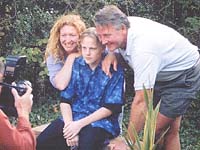
POND/WATER FEATURE
The water feature is made from re-used iron drainpipes, and is powered by a solar panel.Two important wildlife gardening rules have been adhered to in the creation of this pond - shallow slopes to allow creatures to get in and out, and the use of pond plants that are native to Cornwall. Exotic aquatic plants although attractive, can cause devastation in the wild. -
COMPOST BINS/WATER BUTTS
Creating a wildlife garden provides an opportunity to recognise the value of our natural resources. 30% of the household ¦ waste in Cornwall is compostable, so a compost bin is an essential component of the wildlife garden.The installation of water butts enables the collection and use of rainwater rather than consuming treated tap water.
DECKINGAND PATHWAYS
The re-use of materials is a vital part of
wildlife garden design.The less impact your garden design has on the wider
environment, the more wildlife-friendly it is.AII the timber used for
the decking, pathways, handrails, edging and bird tables, comes from a
sustainable source (the sycamore 'slices' are from a dead tree felled
on one of the Trust's nature reserves) or is re-used (the decking is made
from Tommy s old floorboards).

Our thanks go of course, to Robert, but also
to Charlie, Tommy, Kirsty, Willie and all the Ground Force team, for realising
the design and broadcasting to the nation some ways to create a really
attractive wildlife garden.
![]()